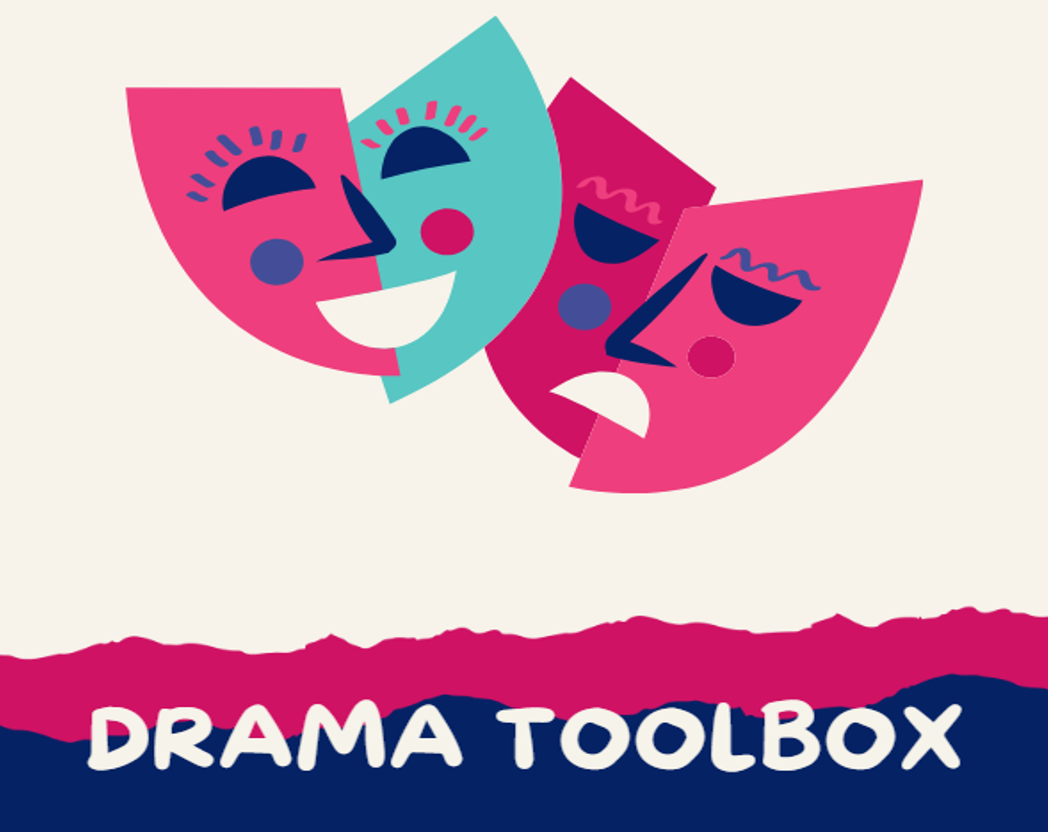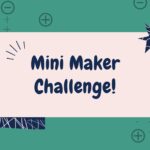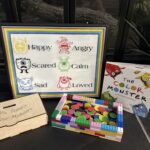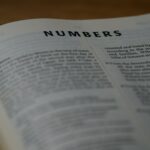Drama activities in the classroom are important because they enhance students’ communication skills, creativity, and confidence. By engaging in role-play and performance, students learn to express themselves clearly, work collaboratively, and understand different perspectives, which helps develop empathy and emotional intelligence. Drama also supports academic learning by making lessons more interactive and memorable, particularly in subjects such as literacy or history. It encourages students to use critical thinking and problem-solving skills, while providing a safe space for students to explore ideas and emotions. Overall, drama enriches the learning experience and promotes personal growth. Below, I have highlighted some activities for the classroom as an introduction to the world of drama.
1.) PAPER PLATE SYMPHONY
- Equipment: 2 Paper plates for each student as well as you the teacher
Standing in a semi circle, have students face each other with their 2 paper plates. The teacher will be the conductor. Students repeat actions of the conductor (teacher) as the they make actions with their paper plates. Up and down motion, double time, scratchy noises, funny shapes and positions. The conductor then plays a piece of music (Instrumental), and the students mimic the conductors moves and actions with the paper plates.
2.) NAME GAME – WHAT YOU DON”T KNOW
- Equipment: None needed
Working your way around the room in a circle formation or in a semi-circle formation have the students sit. Have students one by one state their name and then one thing that others wouldn’t know about them. This could be easily altered by having students state their favourite colour, sport, food, toy etc.
3.) MILLING
- Equipment: None needed
Students walk around the room or space in any direction. When instructed to by the teacher students will “change direction”. Teacher will repeat “change direction” several times before stating “form a circle”. Students will come together and form a circle as fast as they can as the teachers counts down “3, 2, 1”.
4.) MILLING – COPY THE LEADER
- Equipment: None needed
Students will walk around the room or space. It will be decided by the teacher who will be the one who will make the first statue. As the Students walk around, they will wait for the student to make their statue. When the named student makes their pose, the other students must stop milling and make the same pose. That student can then pick the next student to make a pose. Repeat a couple of rounds.
5.) NAME GAME – GESTURE
- Equipment: None needed
Students stand in a circle with the teacher. Teacher starts the game by stating their name in a funny way. Students will repeat name back in the same funny way. The next student will say their name and students and teacher will repeat. Repeat around the entire circle. On the teachers next turn, they will say their name again in a funny way and will add a gesture (i.e. Riding a motorcycle), students will repeat name in a funny way and add the gesture. Play will continue around the circle with each student repeating their name and gesture. On the third round the teacher will start by only doing their gesture, the students will mimic the gesture. The next student will do their gesture and the teacher and students will repeat. Continue around the circle until all students have completed just their gesture.
1st round – name voiced in a funny way
2nd round – name voiced in a funny way with a gesture
3rd round – no sound only their gesture
6) TRANSFORMATION
- Equipment: object to have students transform
Pass an object around for students to transform into another object using few words and mostly actions. A scarf could be a large weight, a baby, a hot dog, a football etc.
7.) GIFTS FROM THE SKY
- Equipment: None needed
Students mill around the room and “catch” something from the sky. They catch it, examine it, use it and it aside, wiping their hands clean (finished) and get ready to catch their next object from the sky. Good use of imaginary skills. i.e. pretend to catch a baseball, examine it, use it, play with it etc. throw it away, wipe hands clean, get ready for next imaginary item).
8.) TAP IN
- Equipment: None needed
A designated student taps another student’s shoulder to invite them to share their thoughts or feelings. A great addition to ‘Gifts from the Sky’.
9.) REAL LIFE POEM
- Equipment: poem that you would like students to examine deeper meaning
In groups of 3 to 5, students will make tableaus that correspond to lines of a poem. The teacher will read out lines and the group of students will pose out their tableau.
10.) OGA BOOGA
- Equipment: None needed
Students stand in a circle. They start by looking down at the ground. The teacher or designated student says “Oga Booga”. Everyone looks up and if the student has eye contact with another student, they are knocked out of the circle. Play continues until there are only two students left.
11.) 123 JEEPERS
- Equipment: None needed
Students stand in a circle. They start by looking down at the ground. The teacher or designated students says “1,2,3 Jeepers”. Everyone looks up. If students have eye contact with another student they must scream loudly and they are out of the game and must take a seat. Play continues until there are two students left.
12.) IF YOU CAN HEAR MY VOICE
- Equipment: None needed
Teacher makes a motion with their hands or arms and says “if you can hear me, do this”. Students will stop what they are doing and will mimic the teachers’ actions.
13.) POEM PARTY
- Equipment: Poem of Teachers choice
Students stand in a semi-circle facing the teacher. Teacher reads poem to students. Students then read poem aloud with the teacher. Teacher reads first line, students read second line and so forth. Teacher reads all but last word in the line, students read the last word in the line. Students and teacher start to read poem in slow motion and get faster each line. Students and teacher start to read poem fast and get slower each line. Students pick a word that stands out in each line and act it out as the poem is read aloud.
14.) Paparazzi
- Equipment: None needed
Have students find a partner, make sure they learn each others name. Ask students to look down at the ground, a designated student or teacher will say “STANDBY” they will then say “ACTION!” Students will have to ‘snap’ a picture of the other student and say the other students name first making a pretend camera with their hands. Variations of the game include having students stand back-to-back, have students turn 180⸰, 360° or 720°. Depending on the students or district you could use finger guns and yell “DRAW” instead of “ACTION!”
15.) Step to the Line
- Equipment: tape line on the floor
Place a tape line on the floor. Students take two steps back from the tape line on either side of it. Teacher makes a statement, “Step to the line if… (you like eggs, you have a dog, have an older brother) etc.” Students step to the line if the question applies to them. Teacher will then ask students to “step back”. Students will resume original position and what for next question.
16.) Two Word Stories
- Equipment: None needed
A small group of students, 3-4, stand at the front of the class. Each student is instructed to say two words before the story moves to the next student in line. The next student in line would then add two more words to the story. Each student contributes two words as the story moves down the line before moving back to the start of the line. The story contributes until the teacher instructs the story to stop.
17.) Conductor Stories
- Equipment: None needed
A small group of students (3-4), stand at the front of the class. An additional student stands in front of them, this is the conductor. When instructed to begin by the teacher, the conductor will point to one of the students who will begin to tell a story. They will continue to tell the story until the conductor points to a new student. The Story will continue until instructed to stop by the teacher. Students could have a story or prompt that they would like to tell or improv the story as they go.
18.) Story Spine
- Equipment: A story spine example (paper or written on board)
Students sit or stand in a circle. One by one students build on a story by starting their sentence with the next section of the story spine until the story is complete. Then a new story begins, starting at the top of the story spine example.
Student 1: Once upon a time… (continues start of story)
Student 2: and every day… (builds story line)
Student 3: and every day…
Student 4: and the one day …
Student 5: and because of that …
Student 6: and because of that …
Student 7: and ever since that day … (student finalizes the story)
Student 8: Once upon a time … (student starts to build new story)
Story creations continue until instructed to stop by the teacher.
19.) Action Stories
- Equipment: a short story that can be told orally while students act out the scenes as the story is read. Example: The Napping House by Audrey Wood
Students decided who will play each character and then act out the part as the story is read. Story can be read by a narrator or the teacher.
20.) Action Stories: Mr. Wiggle/Mr. Waggle
- Equipment: Oral knowledge of the story Mr. Wiggle/Mr. Waggle
Students follow along with the story mimicking the actions as they teacher tells the story. The story goes as follows:
This is a story about two best friends, Mr. Wiggle and Mr. Waggle (Teacher holds up one thumb and then the other). Mr. Wiggle lived in one house (Teacher tucks thumb into hand making a fist) and Mr. Waggle lived in another house (Teacher puts other thumb into other hand making a fist). One day, Mr. Wiggle decided to visit Mr. Waggle. He opened the door, (teacher opens hand leaving thumb down and says “pop”) went outside (teacher raises thumb up and says “pop”), and closed the door (Teacher leaves thumb up and closes hand making a fist and says “pop”). Mr. Wiggle had to go up a hill, down a hill (make story interesting adding movement of thumb and noises) to get to Mr. Waggles (Teacher moves hand around enroute to the other fist). When he arrived at Mr. Waggle’s house, he knocked on the door (Make knocking noise and action on fist). There was no answer. (In the story Mr. Wiggle needs to get back home, so use your story in reverse). Now repeat the story but with Mr. Waggle going to Mr. Wiggles. Finally, start again and this time, Mr. Waggle opens the door. Mr. Waggle opened the door and said, “Hello, Mr. Waggle!” Mr. Wiggle replied, “Hello, Mr. Waggle!” They both laughed and hugged each other. Then they went inside and had a cup of tea together. After that, Mr. Wiggle went back home.
The End
21.) ARTIFACTS
- Equipment: Various items that pertain to the story that will get the students engaged and thinking about the story book
Teacher lays out various artifacts (Such as candle, Quill, Journal, Crown, Witches hat, etc.) that will get the students interested and thinking about the concept of the book you are about to read. Students explore and examine the artifacts for two minutes before the teacher moves on with the lesson.
22. BRAINSTORM
- Equipment: Large sheets of paper and sharpie
Teacher labels each sheet of paper with a subject such as knights or werewolves and asks the students what they know about these subjects prior to reading a story book. Easily adapted to various subjects and topics. Include time and setting if book is from a different time period.
23. LEAD WITH YOUR …
- Equipment: None
Have students spread out around the room. Teacher instructs students to mill around the room. After some time, teacher instructs students to lead with a body part. Example “Lead with your stomach” or “lead with your nose”.
24. PACED MILLING
- Equipment: None
Students form a circle. Teacher counts off A, B, C around the circle to divide students into 3 groups. Group A will mill fast, Group B will mill normal speed, and group C will mill in slow motion. Teacher asks students to mill at their designated speed and they will say “A’s are now normal, B’s are slow motion, C’s are fast” students will begin to mill at their new speed. Teacher will ask students to switch again. Play continues until teacher says stop.
25. THUMB DRIVING
- Equipment: None
Divide students into partners. Divide the pairs up into group A and group B. Person A will be the “driver.” They will then connect thumbs and person A will “drive” persons B’s movements. Partners will switch half way through. Students must try to drive other student allowing them to turn move backwards and forwards.
26. CHOPSTICK DRIVING
- Equipment: Chopsticks
Have students get into pairs. Similar to Thumb Driving the students will divide into Group A and group B. The pair will hold two chopsticks between their thumbs and take turns “driving” the other without dropping the chopsticks.
27. TABLEAUS
- Equipment: None
Divide students in small groups 4-8 students. Students in groups create frozen scenes with their bodies and facial expressions. Teacher should remind students that they should all be at different levels and planes when posing. Students have about 10-15 minutes to plan/practice and then they will present to the class. Other students in the class will discuss what they have seen and what story the students as trying to show. Works great with story books for a story drama.
28. CONSCIENCE ALLY
- Equipment: Tape and storybook
Tape a line down on the floor. Have students stand on either side of the line and share their thoughts from the perspective of a character in a book as one student who is in the role of a character from a story walk down the line.
29. STAGE WHISPER
- Equipment: None
Have students pair up and push against each other’s hands while “stage whispering” a song or statement. For example: Happy Birthday song, Oh Canada, or a Christmas song.
30. PARTNER MIRRORING
- Equipment: None
Have students pair up and face each other. One student will take the lead and the other student will try their best to mirror or mimic the leader’s movements. Students should use different levels and movements.
31. WHOOSH! THEATRE
- Equipment: Script or story
Students stand in a circle while the teacher reads out a script or story. Students are able to voluntarily pop into the circle to fill the role of one of the characters in the story being read. Once the scene is over, the teacher and the students say “woosh!” and the scene dissolves.
32. ALPHABET SOUNDS
- Equipment: None
Have students and teacher form a circle. The teacher begins at the letter A and makes a sound beginning with that letter students repeat the sound. Play continues to the student to the left of the teacher who then makes a B sound. Students repeat the sound. Play continues around the circle.
33. A TELLS B, B TELLS C, C TELLS A
- Equipment: None
Divide students into groups of three. Decide who is A, B and C. Student A tells B a Story, student B tells A’s story in third person to student C, Student C tells A’s story to A in first person.
34. WORKING TABLEAUS
- Equipment: None
Divide students in small groups 4-8 students. Teacher walks around and tell groups a scene or topic (Such as baseball game, rock band, classroom, at the zoo) each group would have a different topic. Students in the groups create frozen scenes with their bodies and facial expressions. Teacher should remind students that they should all be at different levels and planes when posing. Students have about 10-15 minutes to plan/practice and then they will present to the class when instructed to by the teacher. Other students in the class will discuss what they have seen and what story the students as trying to show.
35. POPCORN
- Equipment: None
Students stand in a large circle in the centre of the room. When instructed to by the teacher play begins. Students will spontaneously jump up and say “pop”. If they jump and say “pop” at the same time as another student they must both take a seat. Play continues until there is two students left.
36. ABC 123
- Equipment: None
Students talk to each other only saying “ABC 123” with different expression and emphasise. Have students talk in pairs, then give students a situation such as you are sitting by the fire and these students refuse to share their marshmallows and these students would really like a marshmallow.
37.GIBBERISH
- Equipment: None
Have students push their tongue into their cheek and talk. This is known as gibberish talk. As in ABC 123, students engage in conversation with various emphasise and expression. Combine the two methods and have one group speaking gibberish and the other speaking ABC 123.
38. TALKING PICTURES
- Equipment: Selected images from a graphic book, a piece of instrumental music.
Teacher plays music. Students arrange images from the book in order they feel they belong. Students work in partners or in small groups. Student conduct a gallery walk where students can view how other groups have arranged the images.
39. BACK-TO-BACK
- Equipment: Book, can also been done with just prompts
Have students get into pairs and sit back-to-back. Have students label themselves as A or B. A will play one character and B will play another character from a book. Students conduct a conversation for set amount of time.
40. SYMPATHY CIRCLE
- Equipment: Book, can also be completed from prompts
Teacher has 2 – 3 students create a scene or tableau based on a book or prompt. Teacher asks the rest of the students in the class to decide which of the characters they have the most sympathy or empathy for. Students are asked to stand behind the character they feel the most for.





